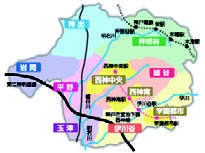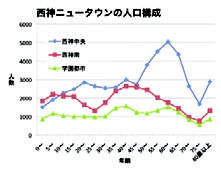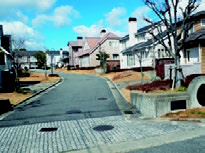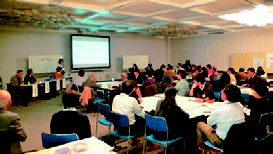In the western part of Kobe City, in Nishi Ward, there is Seishin New Town, developed by Kobe City.
Seishin New Town consists of three new towns, which from west to east are called Seishin Central District (hereinafter, Seishin Central), Seishinminami New Town (hereinafter, Seishinminami), and Kobe Research Academic City (hereinafter, Academic City). Residents have been living there for 22-33 years, and together these areas have a population of about 100,000 people, representing 40% of Nishi Ward's residents.
The Seishin New Town Research Group, to which I belong, has been conducting research and disseminating information primarily about this new town. I would like to introduce the activities of this research group along with the current situation of Seishin New Town.

Seishin New Town areas

Population composition of Seishin New Town
Overview of Seishin New Town
Kobe developed as a city centered on trade and heavy industry following the opening of Hyogo Port at the end of the Edo period.
In response to rapid urbanization, there were already plans for new urban development in the western part of Kobe before World War II. However, full-scale action began with the 1965 Kobe City Comprehensive Master Plan, which stated: "To prevent excessive concentration of population and industry in the existing urban areas, a new town with subcenter functions will be built in the western part of Kobe City." The plan aimed to develop new transportation networks to connect with the urban area while establishing industrial parks nearby, creating Japan's first new town with proximity between workplaces and residences.
The result was the creation of three new towns arranged in stepping stones from east to west on the hills between the southward-flowing Akashi River and its tributaries (Hasedani River and Ikawa River) — Seishin New Town. Located 13-17 km from the city center Sannomiya, it is connected to the urban area by roads and the Kobe Municipal Subway.
As workplaces, special business facility districts within the towns and industrial parks in adjacent areas were developed, with around 230 companies currently established there. In manufacturing, Nishi Ward has become the largest in the city in terms of number of employees and shipment value in recent years, demonstrating the significant role played by the industrial parks.
The area surrounding the new towns is a rural region with thriving suburban agriculture. Various shrines with Noh stages and temples with medieval architecture are scattered throughout, giving a sense of history. The connection with the new towns is also deep through school districts and community farms.
Regarding housing, a distinctive feature is the large number of low-rise, ground-contact townhouses in addition to apartment buildings and detached houses. Shared roads, plazas, and housing are designed as an integrated whole, creating a harmonious townscape. Notable examples include Japanese-style townhouses and the Seishin SV Village, which was built with the participation of the United States and Canada.
Although there is a difference of about 10 years in when residents began moving in, the population situation varies among the three areas.
Seishin Central, having passed 33 years since the first residents moved in, is experiencing progressing aging, decreasing numbers of young people, and gradual population decline. Some hollowing out of the subcenter has also begun.
Academic City has many rental housing units, and while aging is progressing, there are also many young households, creating a balanced demographic composition. It is also a town where more than 13,000 students study at five universities as well as technical colleges and vocational schools.
Seishinminami is the newest town, and due to the expansion of the project area during development, it maintains a population structure centered on young households.
Seishin New Town Research Group Activities
In 2002, a joint public lecture titled "Construction and History of Seishin New Town" was held by universities located in Academic City. This event triggered the establishment of the Seishin New Town Research Group the following year.
For the past 12 years, we have held monthly meetings to learn about the new town and surrounding areas, inviting speakers for research reports and exchanges of opinions. We have also initiated efforts with the hope that citizens will get to know the new town where they live well and develop affection and pride for their community.
We have collected "hometown boasts" from people living in the new town, compiled "30 Notable Spots in Seishin New Town," and held tours within and outside the new town once or twice a year.
Interesting MAP
In 2009, we created an "Interesting MAP" featuring the characteristics of the three new towns and creative or unusual things discovered in the area. It introduces more than 60 points, including a sundial expressing the meridian passing through Seishin Central, drainage gutters inside apartment buildings, a courtyard shaped like a violin, a playing card-shaped police box with heart and spade shapes, a highland settlement site and bronze bell mold on a mountaintop, and an apartment complex with a mini version of Campo Square.
When we provided this as a resource for local studies to all elementary schools in the new town, one principal told us that children were feeling the history and individuality of their surroundings and feeling proud that the new town where they live is wonderful.
New Town People's Connection Conference
In 2012, six new towns—Senri, Senboku, Kozoji, Tama, Tsukuba, and Seishin—gathered for an exchange of opinions about various issues they face, called the "New Town People's Connection Conference," held in Seishin New Town. This is held in rotation by each new town, and for this occasion, we titled it "From New Town to Vintage Town—Creating a New Local Culture, Maturing with the Community" to appreciate the accumulation that comes with an aging new town. We intended to convey the meaning of a town that deepens with age like aged wine.
The symposium was organized in three parts, including people from the six new towns, people engaged in community activities in Nishi Ward, and young people who were born and raised in the new town.
Various community and cultural activities were introduced, and young people also expressed their thoughts about the new town. There were active exchanges of opinions, including proposals for making the new town more attractive.
In fiscal years 2013 and 2014, following the spirit of 2012, more than 20 groups of people active locally and students engaged in community activities gathered to introduce their activities and exchange opinions.
This provided a good opportunity for people involved in various activities in different areas to come together, learn about each other's activities, and interact across generations.

Townscape of Seishin SV Village

Connection Conference gathering (2014)
Aiming to Create a Vintage Town
In Seishin New Town, there are many community activities that support the lives of the elderly and protect the environment. In recent years, there has been an increase in students going out into the community to support local activities. Activities where people pursue hobbies with friends are also thriving, and we also see activities such as holding concerts. Places where jazz lovers gather and shops with delicious cakes have also emerged.
I believe that as these various activities become more vibrant, intertwine like a mesh, and give rise to interactions and collaborations, cultivating attachment, this will lead to people continuing to live there and maturing with the town—creating a "Vintage Town."
Overview of Seishin New Town
Seishin Central District (634ha)
Planned population: 61,000 | Current population: approx. 50,000 | Residents began moving in: 1982
Seishinminami New Town (415ha)
Planned population: 35,000 | Current population: approx. 31,000 | Residents began moving in: 1993
Kobe Research Academic City (302ha)
Planned population: 20,000 | Current population: approx. 19,000 | Residents began moving in: 1985